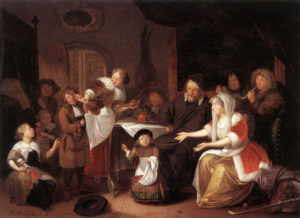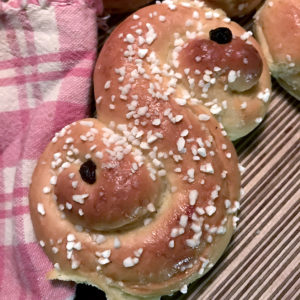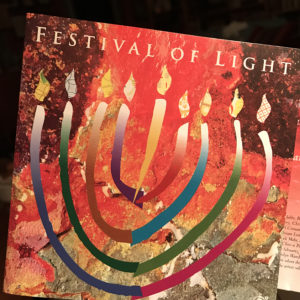
Tomorrow, December 6, is the feast day of St. Nicholas, and tonight, in the overnight hours, St. Nicholas will travel about on his donkey. Wise children will leave carrots and sweet hay in their shoes when they go to bed. When they wake up in the morning, they may find that St. Nicholas has taken the carrots and hay for his donkey, and left fruits and nuts and candies in their shoes in exchange, and maybe some small presents, as well. It’s a sweet and old Advent tradition, part of the countdown to Christmas. And with it, we meet the first of the Midwinter gift bearers. St. Nicholas leads a procession of gift bearers that continue on through Advent and Christmas with others like the Christkindl, Santa Lucia, Father Christmas and Père Noël and Babbo Natale and Santa Claus, los Tres Reyes (the Three Kings) and a kind old witch named Befana who will sweep away the remnants of the Christmas season when it ends with Epiphany on the 6th of January.
That’s a lot of gifts. But these gift bearers harken back to a time when oranges and hazelnuts and marzipan were wonderful wintertime gifts. (Some of us still feel this way; living in a small old house with small old closets, Seth and I really appreciate gifts that are simple and edible.) These gift bearers also are quite regional. As for St. Nicholas, although he was from Turkey and he is a patron saint of so many cities and countries, on this night, St. Nicholas’ Eve, he is known best in Northern Europe, in places like Germany and the Netherlands.
Nicholas in his humanity was a Bishop of Myra in the fourth century. He became known far and wide for his acts of generosity… not the least of which was his hiding bags of coins in the shoes of poor girls who were without dowries. His gift bearer legend grew out of this human kindness. But this Midwinter gift bearer travels not just with his donkey, but also with a dark companion known by various names: Knecht Ruprecht, Black Peter, and Pelznickel are some of them. But he is best known as Krampus: half man, half goat, a bit terrifying… the punisher of children who have been naughty. Perhaps this dark companion comes out of that same humanity of Nicholas’, for we all have our dark side, and maybe the Krampus is Nicholas’ dark side, manifested.
To be sure, St. Nicholas and his companion will be parading in cities throughout Northern Europe tonight. I learn so much from reader comments to the blog and here are two that were posted in the past about St. Nicholas’ Eve: Kelly O’Brien wrote, “I live in Germany & just experienced my first Krampus fest in the Austrian Tyrol region over Thanksgiving. It was terrifying! Not only do modern-day Krampus tout chains and whips, but parade through the village with torches and lots of other fiery devices. The costumes & masks were creepy beautiful, apparently a source of local craftsmanship pride. Do you think this is where ‘going to hell in a hand basket’ comes from?”
And Tad DuBois wrote, “I live and work in Germany and we went to sleep to howling winds last night and awoke to snow and ice. The neighbor’s kinder were all standing in front of their windows watching the snow fly (and no doubt hoping for school cancelations). At my office this morning St. Nicholas and Krampus have just visited. St. Nicholas dispensed candy canes and Krampus had little bags of something dark, coal or reindeer turds perhaps (actually was dark chocolate molded to resemble bits of coal). To be truthful, the Krampus who visited seemed to be a mash-up of Eye-gore from ‘Young Frankenstein’ and Riff-Raff from ‘Rocky Horror.’ Still a wonderful tradition.”
Kelly and Tad: If you’re reading this year, thank you. The parades and the visits from St. Nicholas and Krampus all sound wonder-full. Here in Lake Worth, in these United States, where these legends never gained much foothold (Krampus only has one human foot, after all), our celebration in this house will be much quieter. At our local Publix, they sell St. Nicholas (or St. Claus) cookies in the bakery that come from Steenstra’s Bakery in Michigan. They come in an orange box wrapped in cellophane. Steenstra’s has been selling St. Claus cookies since 1926. They taste of almond and warm spices like ginger and clove, and they depict five different scenes about St. Claus (more correctly about the kind bishop who gave gifts to the poor while they slept). There is St. Claus on a horse (a derivation of that donkey), a boy and a girl (because they like to receive presents from St. Claus), a rooster (because St. Claus starts his day at sunup), an owl (because St. Claus works til sundown), and a windmill (because St. Claus lives in a windmill).
I’ll probably get us some of those Steenstra’s cookies, and maybe tonight we will make some mulled wine, our first batch as we enter this winter, as the first of the gift bearers enters, too. We’ll leave our shoes by the bed, because we always do (again, small closets). St. Nicholas may not make it all the way here from Northern Europe, but Haden the Convivio shop cat will maybe drop one of the stuffed little toys she hunts in the darkness into one of our shoes. She’ll make those mysterious feline hunting noises she makes each night when we shut the lights. We take mystery where we can find it.
Image: “St. Nicholas Eve” by Richard Brakenburgh. Oil on canvas, 1685 [Public domain] via Wikimedia Commons.


